Two leaders, two visions, two aims
- Published

The images of the two leaders working on their letters were strikingly different in tone
Two leaders. Two different aims. Expressed in two different letters. And two very different images to accompany those missives.
The First Minister Nicola Sturgeon has now formally requested the powers from Westminster to hold a referendum on independence, timed to coincide with the conclusion of Brexit negotiations.
In a photo released by the Scottish government, she is shown on a sofa, the very image of shoes-off relaxation, as she signs the letter to the prime minister.
Team Sturgeon laugh off suggestions that this image was a calculated contrast with that of the prime minister when she signed the Article 50 letter, signalling Britain's departure from the EU.
In that image, also an official photo, Theresa May is shown in relatively formal pose. At a desk. Beneath a portrait of Robert Walpole, Britain's first prime minister, resplendently bewigged.
My view? These things tend not to happen by accident, not in the carefully-choreographed world of constitutional politics.
'No rational reason'
Still, to the substance. There, the contrast is just as evident. In her letter, Nicola Sturgeon argues that "there appears to be no rational reason" for the prime minister to "stand in the way of the will of the Scottish Parliament".
By contrast, Downing Street argues that it would be thoroughly irrational to present the people of Scotland with the issue of independence while the shape of the UK, post-Brexit, is unclear. That negotiations have yet to begin, let alone reach conclusion.
Ms Sturgeon's letter opens by wishing the Prime Minister well in pursuing Brexit talks. She notes that "a good deal for the UK is clearly in Scotland's interests whatever constitutional future we choose".
Then she notes that the Scottish government "will play a full and constructive role in securing such an outcome".
That would appear to run potentially counter to such talk as there was at Holyrood yesterday, reflected here, to the effect that MSPs might not readily acquiesce in the Brexit process unless there is parallel progress on today's request for a referendum.
However, it could be argued that the offer of constructive support is predicated upon a presumption of co-operation over the transfer of powers. Note that Ms Sturgeon's letter says "I intend" when talking about Brexit support. That might be seen as a caveat.
Nicola Sturgeon says she will take steps to ensure the UK government respects her request for a Section 30 order
We then arrive at the points of discord. Ms Sturgeon complains that the devolved administrations have not been involved "in any meaningful way" in the preparations for the implementation of Article 50.
Again, there are competing interpretations here. SG ministers are adamant that the prime minister offered to reach a UK-wide agreement prior to Brexit talks. Downing Street says, equally adamantly, that the offer was to consult the devolved administrations - but that the process of leaving the EU will be conducted by the UK government.
Which brings us to another fundamental point of disagreement. Ms Sturgeon proceeds with her argument on the basis of Scotland's entitlement to self-determination. She links this to "the tradition of popular sovereignty in Scotland".
'Clear majority'
Further, she says that the wider principle of self-determination was cited by Mrs May herself in the Article 50 letter. Ms Sturgeon then notes that Scotland's Parliament has now "determined by a clear majority that there should be an independence referendum", building upon the SNP manifesto which said that a further plebiscite could be contemplated in the event of Scotland being removed from the EU against the demonstrable will of her people.
Again, this is fundamental, elemental. The two leaders have two entirely different interpretations of sovereignty. They are dealing with competing and potentially contradictory mandates.
Nicola Sturgeon cites the sovereignty of the Scottish people. She sees the Holyrood vote as a mandate for her to offer a referendum at, or towards the conclusion of, the Brexit talks.
Theresa May refuses to be drawn on the "principle" of a second independence referendum
Theresa May dissents. She argues that the people of Scotland chose, in 2014, to remain within the United Kingdom, to be part of the UK polity, with consequences.
She argues, further, that the people of the UK as a whole, including Scotland, chose to leave the EU in the 2016 referendum. That the choice was by the entire UK - and about the entire UK. That the question was not about Scotland's future, but about the United Kingdom.
Then to the practicalities. Ms Sturgeon says that the 2012 Edinburgh Agreement, prior to the 2014 independence referendum, sets a precedent, meaning that talks this time around could be "relatively straightforward".
She adds further that the choice in indyref2 must be "an informed one". That means holding a plebiscite in Scotland when both "the terms of Brexit and the implications and opportunities of independence" are clear.
Again, Downing Street disagrees. They say the full implications of Brexit may not be known until after the two-year specified negotiation period. That there is a need for transition. That the deal, even when done, needs to settle down.
And the Prime Minister does not want even to contemplate independence talks until there is evident clarity regarding Britain's future.
Two leaders. Two visions. Two aims.
- Published31 March 2017

- Published29 March 2017

- Published28 March 2017
